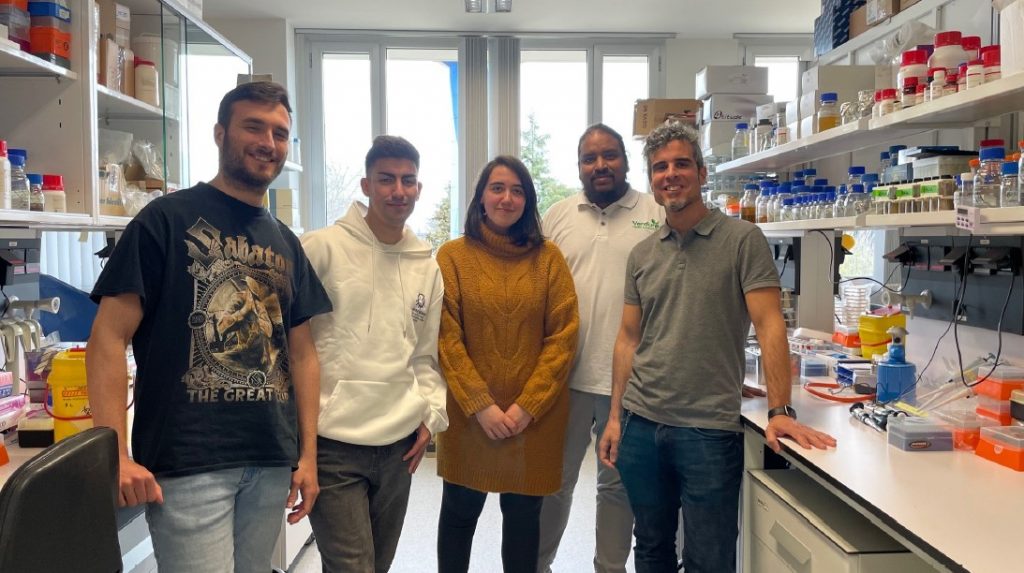Fungal mechanisms to escape the action of azole drugs
and development of novel antifungal strategies
Centro Nacional de Microbiología. Instituto de Salud Carlos III
Jorge Amich
 De izquierda a derecha: Samuel Cano Pascual, Ávaro González Camuesco, Rebecca Lobo Vega, Khalil Ashraph, Jorge Amich
De izquierda a derecha: Samuel Cano Pascual, Ávaro González Camuesco, Rebecca Lobo Vega, Khalil Ashraph, Jorge Amich
Aspergillus fumigatus is a saprophytic filamentous fungus that in nature grows on decaying organic matter. However, through inhalation of airborne spores, this fungus can cause devastating chronic and invasive infections in the lungs of immunocompromised individuals and patients with underlying lung conditions (such as COPD or cystic fibrosis). These infections are termed aspergillosis and have very high associated mortality rates. The main reasons for mortality are the delicate status of patients (often immunosuppressed), the difficulty of reaching a precise diagnosis and the fact that there are only three classes of antifungal agents in clinical use to treat aspergilloses (azoles, echinocandins and polyenes). The azoles constitute the first line for treatment, but worryingly, azole resistance is now globally spread, which jeopardises our best therapeutic option. Indeed, infection with azole resistant isolates severely complicates patient management and increases mortality. Therefore, there is an urgent need to develop new antifungal strategies. Besides, mortality in patients that receive correct diagnosis and adequate azole therapy is still very high (~35% in invasive aspergillosis). The reasons are multifactorial, and we propose that azole persistence may be a relevant and underestimated cause of therapeutic failure.
RESEARCH ACTIVITY
In our group we develop three main research lines, all aimed to alleviate the burden of therapeutic failure.
- Study of the phenomenon of azole persistence: genetic and molecular mechanisms, relevance in treatment failure and methods of detection.
The phenomena of antimicrobial tolerance and persistence are gaining more and more attention. They define the capacity of certain strains of a pathogenic microbe to survive for extended periods in the presence of high concentrations of a cidal drug. In tolerance, all cells of the pathogen show this capacity of extended survival, whereas in persistence it is just a subpopulation of the cells. We were the first to describe that Aspergillus fumigatus can display persistence to azole antifungals, and we showed evidence to suggest that this might be relevant for clinical treatment.
In our investigations on azole persistence, we have three overarching objectives. Firstly, we aim to establish methods to detect and investigate persistence in the laboratory, and methods to detect it in routine diagnosis. For this purpose, we are developing and validating both advanced microscopy-based analyses and straightforward phenotypic assays. Secondly, we have the goal of determining the relevance of azole persistence in treatment failure. To address this major objective, we are using animal models of infection and retrospective clinical analyses. Finally, we are working to unravel the genetic and molecular mechanisms of persistence. We are combining whole genome analysis, transcriptomics and molecular analyses to understand why some strains can display persistence, and also why only a subpopulation of the cells can survive the action of azoles. - Optimization and new developments for the detection of antifungal resistance and persistence.
Precise diagnosis is crucial for the success of antifungal therapy. Indeed, it is imperative to detect infection with persister and resistant isolates, to guide and adequate antifungal therapy. In this sense, we are taking different approaches aimed to improve the diagnosis of resistance, like attempting to enhance the sensitivity of existing assays, developing new, faster assays and detecting it in samples where it is currently not possible. In addition, as mentioned above, we are developing methods to detect and measure antifungal persistence. - Differential modulation of fungal and host persulfidation as a novel antifungal strategy.
Persulfidation is a post-translational modification that consists in the addition of a sulfide (S2-) to thiol groups (-SH) of cysteine residues in target proteins to form a persulfide group (-SSH). This modification has been shown to modulate the intrinsic activity of proteins, having a great impact on physiological and metabolic functions. We have shown that correct levels of persulfidation are required for both A. fumigatus pathogenic potential and the host immune antifungal response. In our current investigations we aim to differentially modulate the levels of persulfidation in the pathogen and the host cells to simultaneously reduce fungal virulence and potentiate the immune response. In addition, we are investigating how persulfidation influences the immune response, which can lead to the discovery of novel interventions to potentiate the antifungal response.
AFFILIATION
Laboratorio de Referencia e Investigación en Micología.
Centro Nacional de Microbiología.
Instituto de Salud Carlos III
Madrid
CONTRIBUTIONS AND SELECTED PUBLICATIONS
- Peláez-García de la Rasilla T, Mato-López A, Pablos-Puertas, CE, González-Huerta AJ, Gómez-López A, Mellado E and Amich J. Potential Implication of Azole Persistence in the Treatment Failure of Two Haematological Patients Infected with Aspergillus fumigatus. J. Fungi. 2023, 9, 805. doi. 10.3390/jof9080805.
- Scott J, Valero C, Mato-López A, Donaldson IJ, Roldán A, Chown H, Van Rhijn N, Lobo-Vega R, Gago S, Furukawa T, Morogovsky A, Ben Ami R, Bowyer P, Osherov N, Fontaine T, Goldman GH, Mellado E, Bromley M, Amich J. Aspergillus fumigatus can display persistence to the fungicidal drug voriconazole. Microbiol. Spectr. 2023 Vol. 11, No. 2. doi: 10.1128/spectrum.04770-22.
- Sueiro-Olivares M, Scott J, Gago S, Petrovic, Kouroussis E, Zivanovic J, Yu Y, Strobel M, Cunha C, Thomson D, Fortune-Grant R, Thusek S, Bowyer P, Beilhack A, Carvalho A, Bignell E, Filipovic MR and Amich J. Fungal and host protein persulfidation are functionally correlated and modulate both virulence and antifungal response. PLos Biology. 2021 19 (6), e3001247. doi: 10.1371/journal.pbio.3001247.
- Scott J, Sueiro-Olivares M, Thornton BP, Owens RA, Muhamadali H, Fortune-Grant R, Thomson D, Thomas R, Hollywood K, Doyle S, Goodacre R, Tabernero L, Bignell E and Amich J. Targeting Methionine Synthase in a Fungal Pathogen Causes a Metabolic Imbalance That Impacts Cell Energetics, Growth, and Virulence. mBio. 2020 Oct 13;11(5):e01985-20. doi: 10.1128/mBio.01985-20
